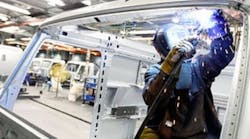WASHINGTON -- U.S. industrial production rose for the second consecutive month in December, continuing the recovery from Hurricane Sandy's devastation, central bank data released Wednesday showed.
"As the distortions from Hurricane Sandy abate, it becomes increasingly clear that a still weak and uncertain global economic picture and a contentious U.S. policy climate have not entirely stopped the U.S. manufacturing recovery in its tracks," said Cliff Waldman, senior economist for the Manufacturers Alliance for Productivity and Innovation (MAPI).
Industrial output rose 0.3% in December following a revised 1% increase in November as industries affected by the power storm that struck the Northeast in October rebounded.
The December increase was slightly above the 0.2% consensus estimate of analysts.
On a 12-month basis, the Federal Reserve said industrial production rose 2.2% in December. That was still a sharp 1.9 points below its level in December 2007, when the economy entered a deep recession that only ended in June 2009.
For the fourth quarter, total output rose at an annual rate of 1%, including a significant upward revision to the October reading, to minus 0.3% from 0.7%.
Manufacturing output rose 0.8% in December, lifted by motor vehicles production. Mining output was up 0.6%; utilities output dived 4.8% amid unseasonably warm weather.
"While the 1% output contraction during the third quarter of 2012 and the tepid 0.2% output increase during the fourth quarter may, because of a host of policy- and weather-related factors, exaggerate the impact of economic and policy encumbrances on the factory sector, there is no question that manufacturing is now in something of a slow growth mode," Waldman noted.
"All told," he concluded, "while the risk of an actual contraction in U.S. manufacturing output has diminished, the economic and policy climate in the U.S. and throughout the world suggest that slow growth for U.S. factories remains the most likely path for 2013."
Copyright Agence France-Presse, 2013
IW Staff contributed to this article.



